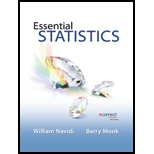
Concept explainers
a.
List all the outcomes in the
a.
Answer to Problem 7RE
The sample space for the experiment is given by:
Explanation of Solution
It is given that three circuits were installed in a computer. There were 12% chances that the circuit is defective. A defective circuit is denoted by ‘D’ and a good circuit by ‘G’.
Sample space:
The set of all possible outcomes of a probability experiment is called sample space of the experiment.
Here, each circuit has two possibilities D and G. Therefore, the sample space of the experiment is
b.
Compute the probability that all three circuits are good.
b.
Answer to Problem 7RE
The probability that all three circuits are good is 0.6815.
Explanation of Solution
Calculation:
Here, circuits are independents to each other.
Multiplication Rule for Independent Events:
For any two independent events A and B,
Required probability can be obtained as follows:
There are 12% chances that the circuit is defective. That is,
Therefore,
Substitute this value in the above formula.
Therefore,
Thus, the probability that all three circuits are good is 0.6815.
c.
Compute the probability that a computer will
c.
Answer to Problem 7RE
The probability that a computer will function is 0.9603.
Explanation of Solution
Calculation:
The computer will function only when two or three of the circuits are good.
Required probability can be obtained as follows:
From part (a),
Therefore,
Thus, the probability that computer will function is 0.9603.
d.
Check whether all three circuits to be defective are unusual or not.
d.
Answer to Problem 7RE
All three circuits to be defective are unusual.
Explanation of Solution
Calculation:
The cut off is 0.05.
Unusual events:
An
Required probability can be obtained as follows:
There are 12% chances that the circuit is defective. That is,
Therefore,
Thus, the probability that all three circuits are defective is 0.0017.
Here,
Therefore, event all three circuits to be defective are unusual.
Want to see more full solutions like this?
Chapter 4 Solutions
Essential Statistics
 Algebra and Trigonometry (MindTap Course List)AlgebraISBN:9781305071742Author:James Stewart, Lothar Redlin, Saleem WatsonPublisher:Cengage Learning
Algebra and Trigonometry (MindTap Course List)AlgebraISBN:9781305071742Author:James Stewart, Lothar Redlin, Saleem WatsonPublisher:Cengage Learning College AlgebraAlgebraISBN:9781305115545Author:James Stewart, Lothar Redlin, Saleem WatsonPublisher:Cengage Learning
College AlgebraAlgebraISBN:9781305115545Author:James Stewart, Lothar Redlin, Saleem WatsonPublisher:Cengage Learning

